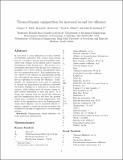Thermodynamic equipartition for increased second law efficiency
Author(s)
Zubair, Syed M.; Thiel, Gregory Parker; McGovern, Ronan Killian; Lienhard, John H
DownloadThiel et al Appl Energ 2014.pdf (543.9Kb)
PUBLISHER_CC
Publisher with Creative Commons License
Creative Commons Attribution
Terms of use
Metadata
Show full item recordAbstract
In this work, a clear distinction is drawn between irreversibility associated with a finite mean driving force in a transport process and irreversibility associated with variance in the spatial and/or temporal distribution of this driving force. The portion of irreversibility associated with driving force variance is quantified via a newly defined dimensionless quantity, the equipartition factor. This equipartition factor, related to the variance in dimensionless driving force throughout the system, is employed to formulate an expression for second law efficiency. Consequently, the equipartition factor may be employed to identify the improvement in efficiency achievable via system redesign for a reduction in driving force variance, while holding fixed the system output for fixed system dimensions in time and space. It is shown that systems with low second law efficiency and low equipartition factor will have the greatest benefit from a redesign to obtain equipartition. The utility of the equipartition factor in identifying situations where efficiency can be increased without requiring a spatial or temporal increase in system size is illustrated through its application to several simple systems.
Date issued
2014-01Department
Massachusetts Institute of Technology. Abdul Latif Jameel World Water & Food Security Lab; Massachusetts Institute of Technology. Department of Mechanical EngineeringJournal
Applied Energy
Publisher
Elsevier
Citation
Thiel, Gregory P., Ronan K. McGovern, Syed M. Zubair, and John H. Lienhard V. “Thermodynamic Equipartition for Increased Second Law Efficiency.” Applied Energy 118 (April 2014): 292–299.
Version: Author's final manuscript
ISSN
03062619